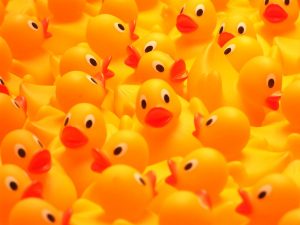
I just got pointed to this article today “Ugly Ducklings – the dark side of plastic materials in contact with potable water“, along with the accompanying commentary “About duck, pipes, and microbiomes“. I think this is a fascinating study for a few reasons. Firstly, like probably most parents, I observed and wondered about the biofilms that grow on bath toys. I was always particularly concerned about things with an internal compartment that kids spray in their eyes and mouths. It doesn’t seem to take for long for this kind of thing to get black and scummy on the inside. So these authors actually went and cut open a bunch of bath toys, plus they added some new toys to clean and dirty water to see what would colonize them. All interesting stuff, and of relevance to the built environment microbiome, particularly that of water systems. I especially like the fact that they did extra work to get abundance information… something that is often missing from amplicon studies. They included both bacteria and fungi which is also nice to see.
While I’m generally not a fan of inferring possible pathogenicity from 16S studies, I think that think that high prevalence of Legionella and Listeria is at least worth thinking about. Abstract of the paper below:
Bath toys pose an interesting link between flexible plastic materials, potable water, external microbial and nutrient contamination, and potentially vulnerable end-users. Here, we characterized biofilm communities inside 19 bath toys used under real conditions. In addition, some determinants for biofilm formation were assessed, using six identical bath toys under controlled conditions with either clean water prior to bathing or dirty water after bathing. All examined bath toys revealed notable biofilms on their inner surface, with average total bacterial numbers of 5.5 × 106 cells/cm2 (clean water controls), 9.5 × 106 cells/cm2 (real bath toys), and 7.3 × 107 cells/cm2 (dirty water controls). Bacterial community compositions were diverse, showing many rare taxa in real bath toys and rather distinct communities in control bath toys, with a noticeable difference between clean and dirty water control biofilms. Fungi were identified in 58% of all real bath toys and in all dirty water control toys. Based on the comparison of clean water and dirty water control bath toys, we argue that bath toy biofilms are influenced by (1) the organic carbon leaching from the flexible plastic material, (2) the chemical and biological tap water quality, (3) additional nutrients from care products and human body fluids in the bath water, as well as, (4) additional bacteria from dirt and/or the end-users’ microbiome. The present study gives a detailed characterization of bath toy biofilms and a better understanding of determinants for biofilm formation and development in systems comprising plastic materials in contact with potable water.

OH my. I have 3 kids that all use bath toys that don’t get especially cleaned all that often. Thanks for the article.